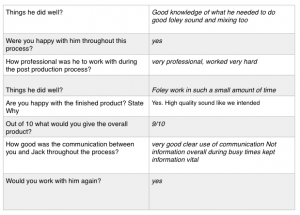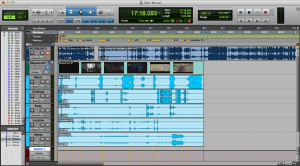This project was very challenging, and although i has many issues to resolve, i feel happy and confident about my overall result of the artefact. Before starting the creative process i set out 3 learning outcomes. These included:
LO1: To undertake the location sound recording of a short film to a professional standard that the client is happy with.
LO2: To undertake the audio post production of the project, including editing, Foley, sound design and mixing, to a professional standard that the client is happy with.
LO3: To research the role & relationship between different audio professionals in the film industry and clearly identify how my role matches up with the project
The first issue i came across was time restrictions. My original idea was to create an electronic music EP, however this proved unrealistic in my experience in this subject and would have involved an incredible amount of research and practice that was unrealistic for me to complete in the time I had. I did have a back up plan, which was to work on the sound of a short film, produced by A level 3 media group. However I joined at quite a late stage, that being around week 5. This meant that i missed out on vital times to conduct my research for this project. However luckily it didn’t take long to find a good media group to work for, for my client based project. I was pointed in the direction of a film called Shafer.
My first Learning outcome involved undertaking research and perfuming the location sound recording. The issues i had with this was time, as stated before i was limited time which effected the quality of research i undertook. Although i looked at a lot of videos and articles, not all of these were credible sources. This meant i went into the location sound recording, not 100% knowing if i was doing things right. The other main issue i had with location recording was the number of people that were involved with sound. That being 1, including me, covering three roles in one. That being boom op, sound mixing, and cable man. This sometimes proved tough, in tight spaces, and in complicated scenes with lots of dialogue. However to resolved this issue, i explained the situation with the producer and director. This allowed me slightly more time between takes, to set up for the next shot, sort out cables, analyse my environment and fill out the sound log to the best of my ability. Sadly, i feel that the quality of recorded audio was effected by this lack of labour. However i feel that i did do a professional job, comparing the location sound research in my blog with the way i worked throughout the shoot. However this could have improved by understanding better techniques. The client was also very happy with it. I send the director a form with various questions regarding my performance in the process:
In terms of the Sound log, i completely agree that this could of been improved. However as stated before due to lack of labour it was difficult to complete alongside everything else.
The second Learning Outcome involved researching and conducting the post production of the audio for the film. Similarly to the last learning outcome, time restraints, meant it was rather difficult conducting ALL of the research needed to complete the project to a professional standard. However i conducted small btw of research and then used books and other research as a reference whilst conducting the oat production. I made sure that i liaised with the director and editors frequently to ensure that the cline (director) felt confident in me and was happy with the overall result. The main issues i came across where yet again time and labour. Labour proved difficult during the foley process and it was very difficult for me to record quality foley, especially in the sound theatre where it requires two people to operate. Therefore I recruited a hand for one or two of the foley sessions. Before mixing i organised a meeting with the director to make sure that he was happy with the product overall at this stage. There was a few things he pointed out that needed to be changed. This proved really useful as i made the revenant changes to make the client happy and making the LO achievable. After using a reference film to set the levels during the mixing stage, the film was screened to the client. However the feedback i got fro, this seas the balance of levels were great but the overall volume was a tad too quiet. To resolve this issue i was given an extra night to complete the mix. I slightly altered some of the sub mixes and increase the master fader slightly, keeping the right balance that the director liked.
I feel i showed professionalism throughout the whole post production process. However to improve i would have conducted more research before starting the process. If given more time, i would have also sent my mix to an industry professional/ expert to analyse his/her opinions of the finished product, and made any relevant changes based on their views. However i feel that the client was exceptionally happy with my professionalism and of the audio of the film.

As a result i feel that i confidently achieved the Second Learning Outcome.
My third Learning Outcome involved researching the different roles and relationships in the sound department of a typical film and identifying how it matches and compares to the role i played. However i feel that this learning outcome was not confidently met. However i did create a table that included the typical roles within the sound department of a film, explained what they are, and how that role compares with the role i played. I also included a screenshot of the people involved in the audio process of a film: Woman in black. To show that i have researched a typical sound department and how they work together. However due to running out of time, and spending all my efforts on the production of the audio, this Learning outcome could not be fully achieved.
Overall i am very happy with the outcome of the Film. I thoroughly enjoyed the process an have a product that i am proud of. As well i have managed to make the director and his team very happy and have been asked to be apart of their next film.
if i was to do this project again, i would make sure that i knew what i was doing early on in the stage, to conduct the necessary research i need, therefore i can jump in with the editing and creative process with more experience and knowledge. I would also i made sure i had a larger team. At least one more person in the location recording, one to mix and one to boom, and perhaps someone to help out with the post production, perhaps splitting the different roles over 2 or 3 people.


